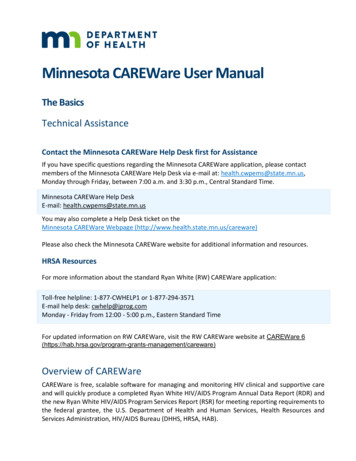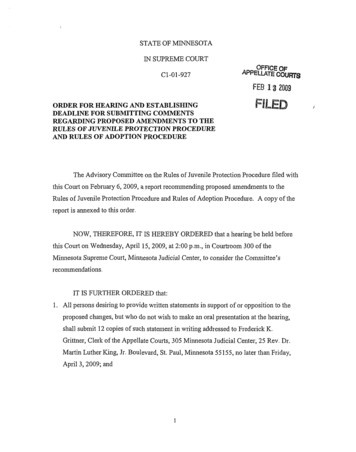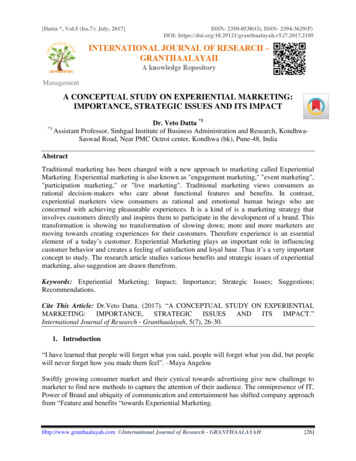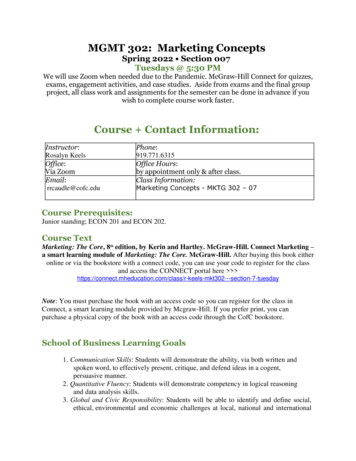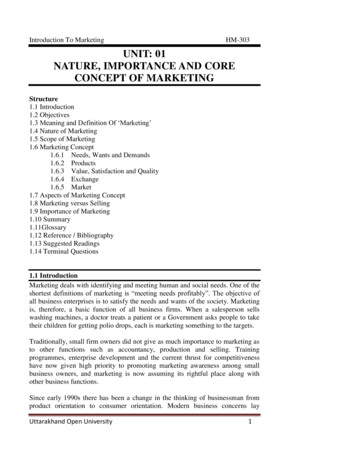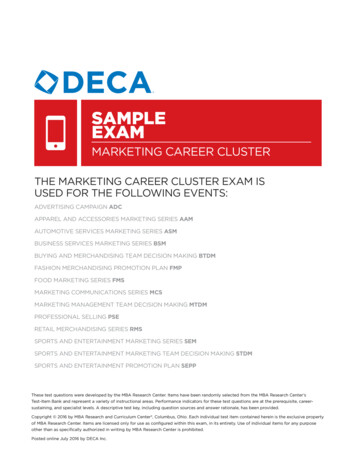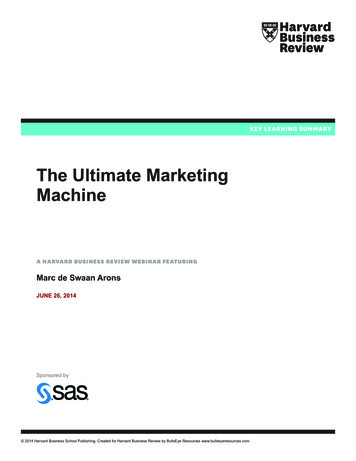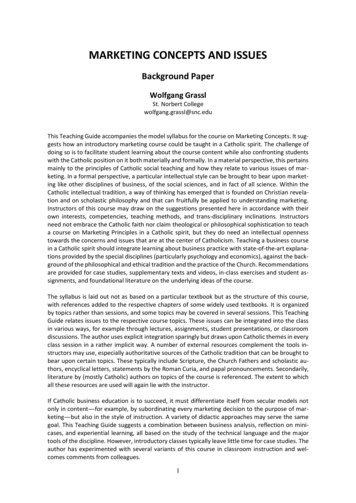
Transcription
MARKETING CONCEPTS AND ISSUESBackground PaperWolfgang GrasslSt. Norbert Collegewolfgang.grassl@snc.eduThis Teaching Guide accompanies the model syllabus for the course on Marketing Concepts. It suggests how an introductory marketing course could be taught in a Catholic spirit. The challenge ofdoing so is to facilitate student learning about the course content while also confronting studentswith the Catholic position on it both materially and formally. In a material perspective, this pertainsmainly to the principles of Catholic social teaching and how they relate to various issues of marketing. In a formal perspective, a particular intellectual style can be brought to bear upon marketing like other disciplines of business, of the social sciences, and in fact of all science. Within theCatholic intellectual tradition, a way of thinking has emerged that is founded on Christian revelation and on scholastic philosophy and that can fruitfully be applied to understanding marketing.Instructors of this course may draw on the suggestions presented here in accordance with theirown interests, competencies, teaching methods, and trans-disciplinary inclinations. Instructorsneed not embrace the Catholic faith nor claim theological or philosophical sophistication to teacha course on Marketing Principles in a Catholic spirit, but they do need an intellectual opennesstowards the concerns and issues that are at the center of Catholicism. Teaching a business coursein a Catholic spirit should integrate learning about business practice with state-of-the-art explanations provided by the special disciplines (particularly psychology and economics), against the background of the philosophical and ethical tradition and the practice of the Church. Recommendationsare provided for case studies, supplementary texts and videos, in-class exercises and student assignments, and foundational literature on the underlying ideas of the course.The syllabus is laid out not as based on a particular textbook but as the structure of this course,with references added to the respective chapters of some widely used textbooks. It is organizedby topics rather than sessions, and some topics may be covered in several sessions. This TeachingGuide relates issues to the respective course topics. These issues can be integrated into the classin various ways, for example through lectures, assignments, student presentations, or classroomdiscussions. The author uses explicit integration sparingly but draws upon Catholic themes in everyclass session in a rather implicit way. A number of external resources complement the tools instructors may use, especially authoritative sources of the Catholic tradition that can be brought tobear upon certain topics. These typically include Scripture, the Church Fathers and scholastic authors, encyclical letters, statements by the Roman Curia, and papal pronouncements. Secondarily,literature by (mostly Catholic) authors on topics of the course is referenced. The extent to whichall these resources are used will again lie with the instructor.If Catholic business education is to succeed, it must differentiate itself from secular models notonly in content—for example, by subordinating every marketing decision to the purpose of marketing—but also in the style of instruction. A variety of didactic approaches may serve the samegoal. This Teaching Guide suggests a combination between business analysis, reflection on minicases, and experiential learning, all based on the study of the technical language and the majortools of the discipline. However, introductory classes typically leave little time for case studies. Theauthor has experimented with several variants of this course in classroom instruction and welcomes comments from colleagues.1
GENERAL APPROACHCatholic Style of ThoughtThe Catholic intellectual tradition has elaborated a number of principles to guide our intellectuallife. They are meant to assist humans in their quest to understand God’s creation and laws, andman’s calling in the world. The essentials of these (formal) principles are the following, presentedwith their implications for understanding marketing:Realism:There is a reality about business (as about other regions of the world) that isindependent of the human mind. The fundamental laws of business are objectively given and therefore notdependent upon human judgment, convention, language, or the will. These laws can be discovered (but not created), which is the task of business studies; there are truths to be discovered about marketing. Reality is structured by levels where phenomena at a more specific levelare explained by laws at a more general (deeper) level. Marketing studies the behavior of consumers and marketers and theirunderlying cognitive and emotional processes and seeks to find the lawsthat govern these. Marketing science prioritizes the study of real phenomena over followingthe trend towards an ever more elaborate conceptual apparatus; Catholicthought has a bias for the empirical and is incompatible with social constructivism and other forms of idealism.Essentialism:For each entity (including humans and their artifacts), there is a set of attributes which are necessary to its identity and function. Market offerings are primarily characterized by essential properties thatmake them fit for the satisfaction of particular needs or wants. Real definitions (by genus proximum and differentia specifica, i.e. nexthigher category and differentiating element) are meant to reveal theessences of things. Humans have an immutable nature from which their actions flow; thisnature does not diminish human responsibility. In marketing, universal elements predominate over any that may bespecific to time, place, and agents. Human nature—the fact of sin and corruption but also the option toovercome it and build virtue—is the psychological basis that explainsmarketing action.Teleology:Everything that has been created is directed at a purpose. Good human action is directed at the purpose of that species of actions. Doing follows being (agere sequitur esse), i.e. action conforms to the being of actors. What something does must be directed at what it is. All products and marketing institutions and activities (distribution structures, advertising messages, promotional campaigns, etc.) are directed ata goal and must serve some human good. Studying intention and motivation is the key for understanding decisionsby both marketers and consumers.2
Normativity:Human actions always have a moral status; this integrates normativity into“positive” research. Ethical judgments, too, are made true by objective features of the world,independent of subjective opinion. Ends sought by marketers or consumers are themselves good or evil(where the production of life-saving devices is as such good and that ofpornography is as such evil). Good marketing requires consumers and marketers of virtue that directtheir actions towards good ends. Mission and vision must guide marketing planning and execution. The success of marketing must not be evaluated by its quantitative (andparticularly financial) impacts alone (marketing ROI, net marketing contribution, gross rating points, etc.) but by its contribution to the integral development of man and society.Integralism:Since reality is a structured and meaningful whole, the intellectual enterprisemust aim at a synthesis of knowledge. We must resist the drive towards an ever greater divisionalization ofknow ledge by seeing science rather as an inter-disciplinary exercise. The explanation of marketing phenomena must be found in more basicsciences in a hierarchy of knowledge, especially in cognitive psychology. The knowledge mankind needs for integral human development is bestdeveloped in community with the Church as the depository of truth. Marketing must draw knowledge from all areas of human experience. Moral issues cannot be resolved by ethical theories that are of a formalnature and are not grounded in truth about God, man, and the world.Form:Form must be given as much attention as is substance, for it is often form thatdistinguishes things one from another. Laws of form describe what is a good fit for human perception. As one of the transcendentals—truth, goodness, and beauty consideredas being one—beauty has an indispensable role in human judgment. Catholicism has developed a deep understanding of signs, symbols, andrituals that may be used to understand the management of meaning. The (hylemorphic) view of products as consisting of matter and form allows for a fruitful combination between realism and design. Design will be subordinate to well-formed aesthetic judgment.Personalism:Human beings are created in the image of God as persons that stand in horizontal and vertical relations with others. Membership in groups (by race, sex, class, nationality) is not constitutivefor humanity. Diversity among humans (together with natural diversity) is to be discovered, not created. Being always takes precedence over both doing and having. Marketing is a human (before it is a social) concern (and science ); it aimsat human flourishing, and it relies on a well-formed conscience. Developing the vertical relations of marketers and consumers to God(and to His law) is of higher importance than the accumulation of goods.3
Many questions in a Marketing Principles course concern how marketing strategies and marketingprograms are expected to work—their task. In Aristotelian-scholastic reasoning, every thing has anature, a purpose, and a task (or function). The task of something is determined by its nature (orwhat it essentially is) and its purpose (or what it is for), where its nature again also determines sdeterminesTASKNATUREdeterminesNATURAL LAWThis model allows us to derive an “ought” (or a task) from an “is” and an “is for”. What intermediaries in a distribution channel should accomplish, i.e. their task, is determined by their nature, orwhat they are,1 and their purpose, or what they are meant to do.2 Their nature in turn determinestheir purpose as its final cause.3 Intermediaries are institutions in the microenvironment of a business that create value for producers and consumers by facilitating transactions. They have a natureand a purpose which whereby their nature as marketing institutions—wholesalers, retailers,agents, or brokers—facilitates the accomplishment of their purpose.This model of reasoning is consonant with the seeing – judging – acting method as proposed byJoseph (Cardinal) Cardijn for arriving at practical conclusions from the nature of something and ajudgment about its purpose.The reasoning on topics discussed in a Marketing Principles course—about products or productcategories, new product development, or marketing institutions such as channel partners—maybe organized around nature, purpose, and task (Grassl 2012a). In so doing, marketing instructionimplicitly draws on the Catholic style of thought.In the Catholic view, identity is defined by what something is, not something one chooses andconstructs. This sets limits to arbitrariness in marketing. Teleological reasoning is implementedthrough mission statements and corporate and marketing objectives, which constrain possiblestrategies and marketing mixes. Together with the other characteristics of the Catholic Style ofThought, it shapes a particular approach to marketing planning and management. For example,effectiveness will be prioritized over efficiency—whether a solution truly gets the job done is moreimportant than whether it gets it done at the lowest possible cost. Competitive advantage willoften be sought at least as much in formal as in material differentiation—in how marketers dothings. In fact, the liturgical model that for Catholics molds all forms of practical life makes what isbeing performed—for example, the Rite of Baptism—inseparable from how it is being done(Guardini 1937, ch. 3; Ratzinger 2000, part 4).1According to agere sequitur esse; Aquinas, Summa contra gentiles III, 69, 20.According to omnes actiones humanae propter finem sunt; Aquinas, Summa theologiae I-II, q.1, a.1.3Ibid., q.91, a.2.24
Catholic Social Teaching (CST)Based on the Catholic intellectual style, over time Biblical ethics and the moral teachings of theChurch have been applied to questions of social order. Particularly since Leo XIII’s encyclical letterRerum Novarum (1891), a body of authoritative Catholic social doctrine has emerged that may beformulated in a number of (material) principles. By a broad consensus, four of these are held to befoundational in an edifice of norms that are then applied to more specific regions of social life. Thesocial thought of the Church is thereby influenced both by theology and by social science:Principles:The subjectivity (or personality)—of humans as subjects of their lives rather thanobjects subordinate to others—grants every person an inviolable dignity that does not derive fromhuman acts (such as a constitution) but from man’s creation in God’s image. The intrinsically socialnature of persons reflects the most perfect community found among the three Persons of the HolyTrinity. Love is thus ordained as a commandment and given as a gift of the Triune God; solidarity5
among mankind is the living out of this command. It builds human community. However, the dutyof solidarity is not unbounded, for only God can love perfectly. Solidarity, which for humans is ascarce good, must itself be ordered according to the principle of subsidiarity: it should first be applied closest to the person—in families, among friends, at the workplace, in local communities—before it is extended to others who are unknown (such as to the state at large). Where solidarityis the material principle of social life, or the “glue” that holds society together, subsidiarity is theprinciple that rules proper social organization, which according to CST is to be bottom-up. If thesethree rules are observed, common goods will be produced in the various areas of social life. Thecommon good regarding work is the development of firms as communities of persons; the common good pursued in the natural environment is the maintenance of a high quality of environmental resources and their protection for future generations; the common good in international relations is peace and cooperation between nations, etc. Other precepts of CST follow from these fundamental principles: a respect for life in all its stages; the support of families; the exercise of socialjustice; a special dedication to the poor; the right to participate in public affairs; protection of personal property; good stewardship of resources, etc.Objective:Recent CST as expressed particularly in the encyclicals Centesimus Annus (1991) byJohn Paul II and Caritas in Veritate (2009) by Benedict XVI emphasizes that all these human endeavors serve but a single objective—to foster integral human development. This means that allprivate and public action must be directed at supporting the development of the person both inhorizontal and vertical directions, by becoming more not only through more income, wealth, possessions, or power, but also by growing into a greater likeness of Christ. In Christian anthropology,being always precedes having, and persons are seen according to their intrinsic worth rather thantheir possessions or success in professional life.Business:Recent CST has overall taken a positive view of enterprise by emphasizing the contribution business can make to integral human development. Free markets support a better resource utilization and allow for the satisfaction of individual desires and preferences. However,they have moral limitations by also facilitating social evils and by generating inequalities within andacross societies. For this reason, government has a necessary role that is limited by subsidiarity.Like other forms of property, businesses work under a “social mortgage” and must not only maximize profits but do so by producing good and safe products, providing fair wages and decent workconditions, and contributing to the goods of the wider society. The visions of social structure thatanimate recent CST are tripartite: John Paul II identified the three spheres of the social whole aseconomics, politics, and culture, whereas Benedict XVI spoke of the market, the State, and civilsociety. For both popes, culture respectively civil society was to be the agent driving the otherspheres towards creating conditions that foster integral human development.Teaching Marketing in a Catholic SpiritMarketing is both a business function, and thus an activity, and the systematic study of it. Obviouslya particular understanding of the first informs the specific approach chosen to the second. A distinct understanding of marketing as a functional area of business will then pervade the entirecourse. It derives from Christian anthropology, a Catholic view of the purpose of business, themoral relevance of every managerial decision, and from the Catholic understanding of the unity ofthe intellectual enterprise.Marketing as activity: Marketing as a business activity comprises all those decisions and actionsthat plan, create, distribute and communicate value for customers. Although it is not the only approach, regarding marketing as the management of value, where value is understood as the ratio6
of benefits delivered and the costs of obtaining them (V B/C), is compatible with a Catholic viewof business. Under this view, value creation necessarily involves consumers. But marketing dealsnot with what producers offer consumers but rather with a set of multilateral relations betweenmarketers, consumers, and other stakeholders (such as distributors and regulators).Principles:Marketing as a human practice is guided by practical reason, but also by desiresand emotions, and lastly by the social and economic situations of consumers and marketers alike.The principles of marketing are then not a set of universal rules that can be recorded as in a recipebook and then mechanically be applied to business situations. They are instead principles of practical reason that derive from knowledge about human nature. As such they are generally valid. Butdifferences of time and place, including different cultural settings, may lead to different rules beingimplied by the same human nature. While generalizations (that we often regard as “laws”) of marketing are typically formulated against the background of high-income industrialized economies,the severe scarcity natural disasters can bring about in less developed economies would invalidatemany of them.Ethics:Teaching marketing in a Catholic spirit must by no means be mistaken for moralism. The heavy emphasis on business ethics that has in the past two decades been fostered byorganizations such as AACSB is a blessing in disguise. Business ethics has long been regarded asexternal to business—indeed, as a corrective to it or to the results of economic activity. Moralityhas been located in management actions, respectively the mental dispositions underlying them.Consequently, business ethics has been regarded as a discipline in relative autonomy from businessadministration. Recent CST takes a radically different approach (Ratzinger 1986). Benedict XVI’sencyclical Caritas in Veritate does not postulate dichotomies between the domains of business andmorality. The Encyclical does not condemn efficiency, rational choice, the market, or even selfinterest. Rather, it points to their limitations and emphasizes that a correct ordering of thesemeans towards a transcendent goal is necessary. Efficiency is not good simply because it allows forgreater outputs with fewer factor inputs. Rather, it is an imperative of creation, ennobles the calling of human beings, and may in some cases be required by the precautionary principle. Wheresecular ethics attempts to develop rules for conduct in business, CST is dedicated to the demonstration that such rules are without foundation if they do not derive from a transcendent order(Benedict XVI 2009, §§ 11, 29, 34, 45). Instead of treating ethics as exogenous to business, whichthen has to be applied to marketing decisions, it is better viewed as endogenous to it (Grassl 2012;Grassl and Habisch 2011).Religion:Much as morality in business is necessary for its proper functioning, and much asethical analysis is desirable to guide managers, social or individual ethics cannot substitute for religion, as Kant proposed to do. Since morality must be distinguished from mere moralism, expecting too much of man means moving him into the sphere of the divine. CST thus seeks to departfrom the dominant model of business ethics as a prosecutor of business and, since every decisionhas a moral character, seeks to see its role as that of an advisor to business (Grassl and Habisch2011). According to the logic of Caritas in Veritate, business ethics should seek a deep integrationof ethical thinking into the mindset of managers and should thus become preemptive. The discipline is itself called to participate in the creative work of developing alternatives, in an offensiveand entrepreneurial rather than a narrowly defensive and prosecutorial spirit. Benedict XVI reminds us time and again that the biggest defect of most businesses is not one of commission butof omission—that they do not live up to their potential in contributing to integral human development. An ongoing reflection on CST in the Catholic Style of Thought therefore makes separate sections on marketing ethics, which are often little more than add-ons, unnecessary. This in no wayreduces the value of studying the human and social consequences of marketing decisions. But itsuggests that religion may be a productive challenger for marketing to be more effective.7
Integration:The specific character of teaching marketing courses in a Catholic spirit lies then in(1) seeing marketing as a function of business that itself must serve human needs, rather than asan autonomous field; (2) applying to it the principles of CST; (3) understanding business and marketing from the intellectual and spiritual resources of the Catholic tradition; and (4) using the Catholic Style of Thought (where they apply) to explain the principles of marketing.Beyond postulating the principles of CST as free-standing axioms that derive their normative forcefrom encyclicals, they can be shown to follow from an eminently reasonable and well-developedview of the role of persons and their social nature in the universe. It is not necessary to dip directlyinto dogmatic theology to do this. CST can be presented as a whole composed of interlocking andmutually sustaining parts that together make the social sphere intelligible and meaningful. Ourthinking and acting occurs at various levels. By taking two principles as examples, the followingmodel demonstrates what is meant, where n is that level at which the principles of CST are located:Ontological Level PrinciplespriorityLeveln 2Entrepreneurship as vocation; joy in creative work Marketing educationn 1Decentralized sales teams; distributed internaMarketing principlestional marketing; support for employee ownershipnPrinciple of subsidiarityCSTn-1Persons are social individuals; human freedomCITn-2World is a structured whole ( atomism)Theology/Philosophyn 2Making individual human worth central in business Marketing educationn 1Truth in advertising; product safety; abstentionfrom stereotyping; giving consumers choicesMarketing principlesnPrinciple of human dignityCSTn-1Man created in the image of God (imago Dei)CITn-2God’s love and grace (Deus caritas est)Theology/PhilosophyStructure ofexplanationAs in all empirical disciplines, explanation procedes by reduction whereas the ontological structureof reality is emergent. The teaching of marketing ought to be guided by marketing practice asviewed through the lense of CST; the latter is an application of the principles of the CIT, or of theCatholic Style of Thought, to the social sphere; and these principles are ultimately grounded inrevealed and rational truths of our faith.The structure of reality is the reverse of this order of explanation: God is the ultimate reality, withour understanding of the world, society, marketing activity, and our teaching of it, being locatedat emergent levels above it. Subsidiarity is a normative principle because it is founded on the worldas a structured whole, which is the Biblical teaching and that of the Church Fathers and of St.Thomas Aquinas; it harbors recommendations for how marketing management should be organized, and lastly how marketing should be taught. What we should convey in marketing courses,and how marketers and consumers should behave, then follow seamlessly from an integrated andmeaningful view of reality. The interconnectedness of levels is important here and needs to becommunicated in our curricula. This is certainly not an easy exercise.The following (incomplete) model may exemplify this integration:8
Catholic social doctrinerelatedness:defined by relations;imago Deipersons:individuals with intrinsic dignitysolidarity:horizontal relationsof respect and lovesubsidiarity:vertical relations ofordered supportcommon good:individual interests common interestsocial values:peace, justice, environmental quality stewardship:materialbest principles(long- term)use of resourcesCatholic :coheres with business education asapplied to consumers and producersrealist orientation:not anonymous social forces but concrete persons acting responsiblyteleological:which purpose is served, for whichbeneficiaries, and by which means?value:emphasizes creation of individual andsocial value : V (Bn*wn)/ (C)social impact:how value affects quality of communities (positive externalities)ethical:true goods and services that truly serve (commitment to value judgments)planning levels:hierarchy of levels under emergence:mission strategy tactics operationsobjectivism:world has structureindependently ofuscoherence:reality is a structured coherent wholeteleology:creation has a purpose outside of itanalogia entis:inference from creation to Creatorrealism:truth can in principle be knowncomplexity:knowledge is partialand contradictoryformalprinciplesfaith andreason:complements butare applications ofINTEGRATION INTO SYLLABUSTopic Catholic thought integrated into course topicsInstructor’s Resources0Introduction A Student’s Prayer (St. Thomas Aquinas) What can one learn/teach about business? Grassl 2009 Attitudes towards business Truth about business Learning to be successful in life and in a profession Grassl 1999 What students can expect to learn from this course1Marketing and Customers What is the proper purpose of business? What is the proper purpose of marketing? What does it mean to serve customers? Servant leadership Creating a service culture for customers: CRM* Active vs. passive roles of marketers* Quantity vs. quality of customer service Relationship marketing Cortright & Naughton 2002; Johnson,Naughton & Bojan 2013 Discussion of Levitt 1975; Murphy et al.2004 Mark 10:41-45; Luke 1:38 Mark 1-13; Matt 23:11 Eph. 6:6-8; “Zappo’s Marketing Chief:‘Customer Service is the New ng Discussion: When are relationshipstrue?9
2Catholic View on Marketing Principles of Catholic social doctrine Pontifical Council for Justice and Peace2004; Benestad 2011 Catholic understanding of business and marketing Klein & Laczniak 2012 Human action Who benefits, who bears costs? Virtue of marketers Benedict XVI 2009, 66 Responsibility of consumers Murphy, Laczniak & Prothero 2013, Ch.1 Ethical issues of marketing Santos & Bagha 2013; Video: Drug Ethical vs legal issuesCompanies Conduct Research in India; “A Subjective vs objective goods: agreement onHeaven for Clinical Trials, a Hell for India”ethical l3The Marketing Environment Can and should a business influence its macroen-vi- * Discussion: How is meaning being marketed?ronment? What duty do businesses have in politics? Exit, voice, or loyalty: reactions to adverse environ- Hirschman 1970mental trends4Corporate and Marketing Strategy In formulating a mission, who actually “sends”? How can strategy be mission-driven?5Managing Marketing Information Is protection of data a human right? What are the ethical limits of data mining?6Understanding Consumer Behavior Is the distinction between needs and wants real? Are all needs provided for by markets? Are wants created by marketing? Problems of Consumerism7Understanding Business Buyer Behavior8Market Segmentation and Targeting Is there a natural way to “carve up” markets? Are there essential structures in markets? Which segments should not be targeted? Marketing to the poor Marketing to children9Positioning and Competitive Advantage Illusion and truth in positioning Can companies achieve mixes between cost andproduct advantage? Grassl 2012a John Paul II 1991, 34, 36 Beabout & Echeverria 2002; Cavanaugh2008 ; Gilbride 2013; http://cappusa.org/contemporary issues/19 Plato, Phaedrus 265e Grassl 1999 Santos & Laczniak 2009 Moore 2013* Discussion: Marketing as influencingconsumers’ minds – an attractive view?10
10 Products and Brands Overview of product policy decisions A natural classification of products: substances vsartifacts; natural kinds as substances What is the optimum complexity of products? Brands: relationship between signs (brand elements) and substance (branded product) Naturalness of brands* Discussion: When are produ
MARKETING CONCEPTS AND ISSUES Background Paper Wolfgang Grassl St. Norbert College wolfgang.grassl@snc.edu This Teaching Guide accompanies the model syllabus for the course on Marketing Concepts. It sug-gests how an introductory marketing cour


